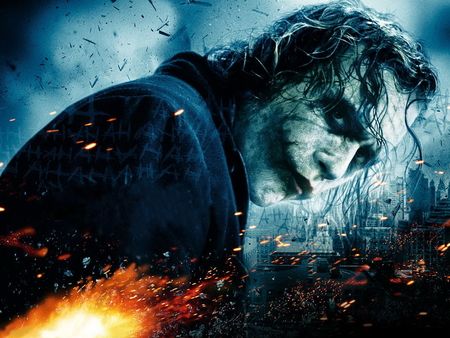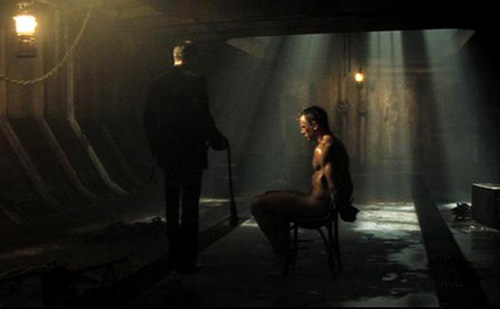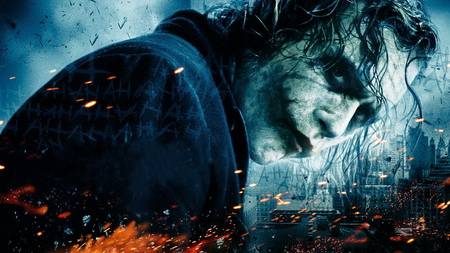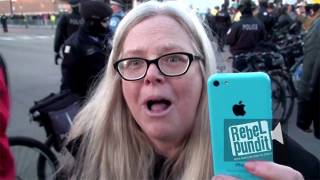Our attitude to violence is beyond a joke as new Batman film, The Dark Knight, shows (2008)
Source: telegraph.co.uk
The new Batman film reaches new levels of brutality, so why are we letting children watch it? Jenny McCartney looks at a society seduced by sadism. 
If I were 10 years old, would I be badgering my parents to take me to see the new Batman film, The Dark Knight? You bet I would. It’s the latest and biggest release in the superhero genre, which children instantly understand as a direct appeal to their special interests.
It’s also touched with the alluring suggestion of forbidden fruit: the maniacal, deranged face of The Joker, grippingly played by the late Heath Ledger, leers from posters all over town.
If I were the parent who relented and took a 10-year-old child to see The Dark Knight, would I be sorry? Once again, you bet I would. It’s different from other superhero films, as fans are quick to point out. Certainly, there are surprises in its swooping camera angles and darkened, ominous screen.
But the greatest surprise of all – even for me, after eight years spent working as a film critic – has been the sustained level of intensely sadistic brutality throughout the film.
I will attempt to confine my plot spoilers to the opening: the film begins with a heist carried out by men in sinister clown masks. As each clown completes a task, another shoots him point-blank in the head. The scene ends with a clown – The Joker – stuffing a bomb into a wounded bank employee’s mouth.
 After the murderous clown heist, things slip downhill. A man’s face is filleted by a knife, and another’s is burned half off. A man’s eye is slammed into a pencil. A bomb can be seen crudely stitched inside another man’s stomach, which subsequently explodes. A trussed-up man is bound to a chair and set alight atop a pile of banknotes.
After the murderous clown heist, things slip downhill. A man’s face is filleted by a knife, and another’s is burned half off. A man’s eye is slammed into a pencil. A bomb can be seen crudely stitched inside another man’s stomach, which subsequently explodes. A trussed-up man is bound to a chair and set alight atop a pile of banknotes.A plainly terrorised child is threatened at gunpoint by a man with a melted face. It is all intensely realistic. Oh but don’t worry, folks: there isn’t any nudity.
What’s the problem? I can already hear some people asking. It’s all a comic-book fantasy, and comic books are well known for their surreal, cartoonish bursts of violence. But the director, Christopher Nolan, hasn’t sought to ramp up the cartoonish aspects of his superhero story, as other directors before him have. He has tried instead to make the violence and fear as believable as possible, and in this he has succeeded.
The Dark Knight, however, has been rated 12A by the British Board of Film Classification, which means that although the BBFC believes it is best suited to children aged 12 and over, any under-12 can see it provided he or she is accompanied by an adult. Cinemas are even holding parent-and-baby screenings.
The 12A certificate, a relatively recent innovation, is a piece of fudge designed to deflect responsibility from the BBFC on to British parents. I have some sympathy with the BBFC regarding the origins of this fudge.
In 2002, the BBFC took a stand on Spider-Man, a hugely hyped Hollywood release: it decided that it contained unsuitable levels of violence for under-12s, and therefore awarded it a "12" certificate, meaning that under-12s should not be allowed into cinemas to see it.
A public storm erupted; children and many parents were furious; and a number of councils announced their intention to defy the ban. At first the BBFC stoutly defended itself, saying that "Hollywood has carried out an aggressive worldwide marketing campaign aimed at young children when the film is not suitable for them." And then, fed up with being everyone’s most hated Aunt Sally, it invented the 12A certificate, which translates as a fed-up, institutional shrug of the shoulders.
It’s been busy shrugging ever since. Spider-Man now looks like Bambi when set next to The Dark Knight. Even since 2002, the public’s willingness to expose children to previously unthinkable levels of screen violence has soared, and the BBFC finds itself virtually powerless to stop it.
Casino Royale (2006), the most recent James Bond film, was also given a 12A certificate: young boys in particular are attracted to Bond just as strongly as adults are. Many well-meaning parents, lulled by memories of the stylised, somewhat camp nature of Bond films in the past – and perhaps reassured by the softer 12A rating – were minded to indulge their younger children in a sophisticated treat. But Casino Royale, starring Daniel Craig, was in fact a new kind of Bond film, shot like a realistic action thriller.
Parents and their open-mouthed children found themselves watching a scene in which a bloodied Bond, stripped naked and tied to a chair, is tortured by having his genitals beaten with a length of rope. A friend of mine was somewhat dismayed afterwards to witness his two young boys, aged nine and seven, diligently re-enacting the torture scene with an outsize teddy bear strapped to a chair and a flail constructed from a knotted dressing-gown cord.

Even in fantasy films, such as the Harry Potter series, the competition among directors is to ratchet up the level of "darkness": in the 2005 film Harry Potter and the Goblet of Fire, the intensity of the scenes involving the evil Lord Voldemort and his servants the Death Eaters caused the BBFC to upgrade its rating from a PG to a 12A.
I believe, however, that there is some distinction between violence which is clearly fantastical in origin, such as that in Harry Potter, and that which is realistic and sadistic in tone, such as that in The Dark Knight.
The former might well bother younger children afterwards, and even give them horrifying nightmares – scarcely desirable in itself – but the latter is more likely to taint their fundamental vision of the world and adult norms of behaviour. The intensity of violence in The Dark Knight is a grimly logical progression from the sort of distilled brutality that has rapidly become the norm in films rated 15 and 18: the only difference is that now small children are permitted to watch it, too.
As a reviewer, I naturally understand that a degree of violence is an unavoidable force in cinema, as it is in life, and that a talented director can employ it to say something meaningful. Yet since 2000, when I first began reviewing films for The Sunday Telegraph, sporadic scenes have brought me up short, because they seemed to signal a sudden, significant shift in the director’s moral perspective.
One such came in 2004, while watching the Tony Scott film Man on Fire. Denzel Washington, an actor of great natural dignity, plays a jaded former assassin who becomes a bodyguard for a wealthy little girl: when the child is abducted, he embarks on a relentless quest for revenge upon those who did it. In the course of this bloody quest – and with the assumed approval of the audience – he shoves a bomb up the rectum of a Mexican conspirator, then triggers its explosion. Washington, I should emphasise, remains the film’s hero.
Once, Quentin Tarantino was the edgy enfant terrible of Hollywood. Now he is a member of its establishment, encouraging younger, mainstream "torture porn" directors such as Eli Roth to push the boundaries of explicit, ingenious cruelty ever further.
Increasingly, extreme screen violence is used not as a necessary adjunct to a greater point, but as the pleasurable point in itself. Wanted, this summer’s otherwise risible action blockbuster starring Angelina Jolie and James McAvoy, has as its theme the murderous adventures of a fraternity of assassins. McAvoy, again the hero, is portrayed as a hopeless nobody until he "finds himself" by unleashing his killing streak and is thereby empowered.
The Joker, too, croons over his own penchant for knife killing: "Guns are too quick. You can’t savour all the little emotions." He’s not officially the hero, but he might as well be: next to him, Batman pales into insignificance.
Britain appears to be gulping down entertainment values wholesale from a Hollywood intent upon mining the profit margin from barbarism. America, for all its manifold strengths, is still a country in which the population can be roused to a frenzy of condemnation by the sight of Janet Jackson’s escaped nipple on the Super Bowl, but views the sight of a bound man being torched to death as all-round family entertainment.
Just as notable as the burgeoning violence in popular entertainment itself, however, is the rage directed at anyone who dares to question it. Earlier this year, I wrote what I thought was a fairly balanced piece criticising not all video games, but extremely violent ones such as the 18-rated Manhunt 2, which the BBFC repeatedly attempted to ban before being over-ruled in court.
The gaming websites went wild with furious responses. There was a smattering of well-put points, but numerous other responses were intent upon telling me variously to "f*** off"; that I was a "silly c***" for raising the issue, or that I deserved my "skull caved in Manhunt-style". It was clear that, whatever the constant playing of violent computer games had taught many such enthusiasts, it was not the ability to engage thoughtfully with a differing view.
An echo of the same phenomenon can already be seen in the US, where any film critic who expresses measured dislike of The Dark Knight faces hundreds of intensely hostile online responses. The more violent the source of entertainment, the more vitriolic its fans grow in defence of it: there is a whiff of the enraged mob at Tyburn, furious at anyone who attacks its right to thrilling, primal pleasures.
Is there a link between screen violence and actual violence? Fans of violent films will tell you – frequently in the most aggressive terms – that there is not. Yet we know that children are, to greater and lesser degrees, highly imitative of what they see. We know that there is escalating public concern about violent crime, particularly knife crime, among teenagers.
And we know that entertainment aimed at young people is becoming markedly more violent. My generation was terrified by the Child Catcher in Chitty Chitty Bang Bang; the current one is diverted with torture and agonising death.
Little boys have always played with swords and guns. But they did not always play at beating a prisoner’s genitals with a rope, or stitching a live bomb inside a man’s stomach. For that innovation we must thank Hollywood, the industrious factory of dreams, now frequently devoted to churning out nightmares.
The poet WB Yeats once wrote, "In dreams begins responsibility", yet Hollywood will never take responsibility for its most brutal dreams so long as the paying public still flocks to the theatre of cruelty.
Article from: telegraph.co.uk
The Dark Knight Rises: Gunman kills 12 at movie screening in Colorado
Zombies and Our Thirst For Gore






















